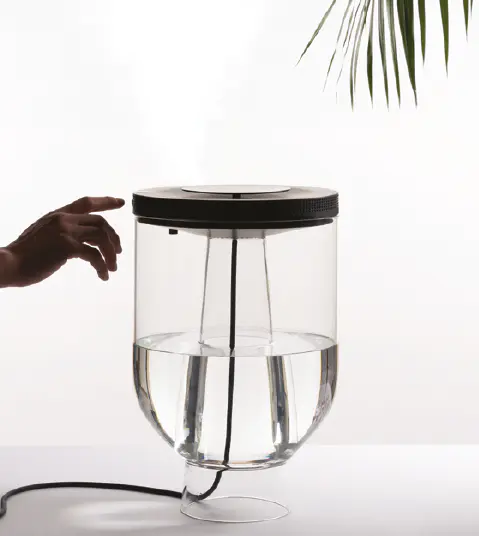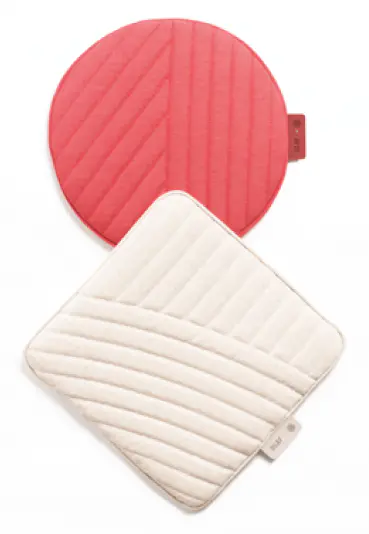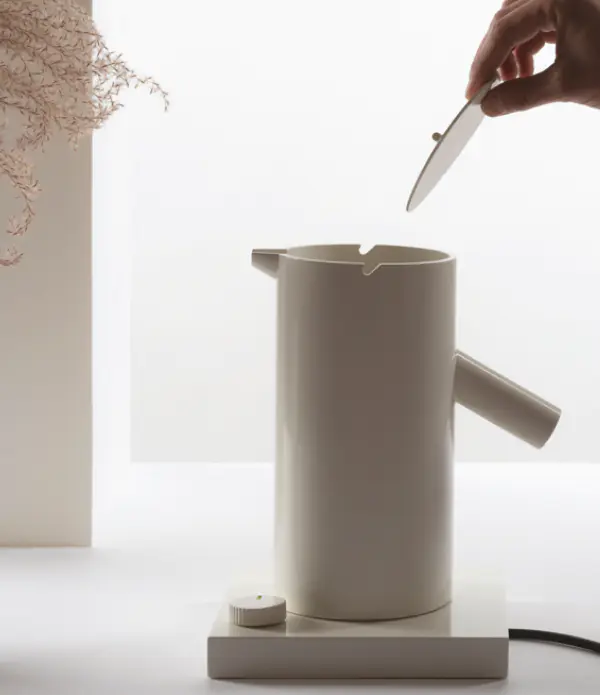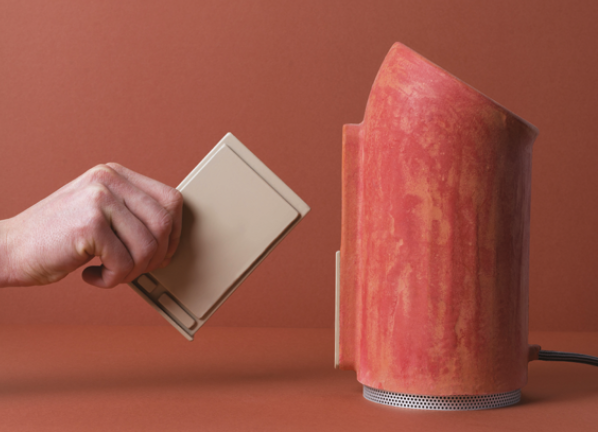Natacha.Sacha.
Paris-based young designers Natacha Poutoux and Sacha Hourcade are particularly interested in unassuming everyday objects which we normally don’t really pay attention to, like small domestic appliances, generally considered as mere technological commodities. They start by taking these objects apart to understand how they work, and often find out that they are a lot simpler than they appear. For instance, by taking an air humidifier apart, they realised that its motherboard was barely 2 square inches large. All the appliance did was to turn water into steam, but with its flashy and imposing plastic casing it looked like it was highly technological. They re-shaped it into a beautiful, yet highly functional element of interior design. In this exclusive interview for Design Magazine, they tell us about how they reconcile technology with craftsmanship and sustainability.

Métis 02 is a smart air humidifier, which measures and regulates the percentage of humidity inside a room.
Q: You take established design conventions of everyday objects and completely revolutionise them. Is that what you do?
S: What we try to do is to give these objects more of a balance for a better and more harmonious integration into a home interior context. Our approach is to design appliances just as we would design an element of furniture, like a chair or a sofa. Appliances tend to overplay their tech-side, but that’s simply due to the fact that they are designed that way, while we try to bring them back to a universe of softer shapes, much more in line with their intended use and our lifestyles. Our choice of materials follows our intent to give these appliances a more virtuous, sustainable lifecycle, but also to create stronger ties between industrial production and traditional craftsmanship, which would benefit local communities.We are also researching mew protocols to make domestic appliances more durable and sustainable, putting their production processes in question. At the end of last year, we stayed in Japan for two and a half months to further investigate the subject. We met with several appliance makers, to see whether and how traditional products could be re-designed, engineered and industrialised, maybe on a smaller, local scale. Our intent was to increase the part craftsmanship plays into the manufacturing of these objects. For this we met with both industrial tech-players and more traditional actors whose trade relied on manual work and ancestral know-how. Our hope was to create synergies and virtuous partnerships between the two worlds.
Q: What is you relationship, as designers, with the world of tech?
N: We realised that in the industrial world, there is often a lack of open communication between engineers and designers, and sometimes this can result in companies giving themselves some overly stringent industrialisation criteria, making it difficult for new design concepts to make it to the production stage. For instance, we met a traditional producer of wood containers to refrigerate and heat sake, who had worked with an electronics multinational in view of producing an industrial, tech-version of it. That object failed to make it to the industrialisation phase since wood is a material that “breathes” naturally, with small variations in volume and dimensions, thus failing the company’s self- imposed tolerance limits for product specifications. If such rigorous standards were meaningful for products made of plastic, they made little sense for natural wood since the final product would still maintain all its qualities and be perfectly functional. These self-inflicted limitations occurred over time, but its high time to reconsider them especially when experimenting with more natural materials.“Many appliances aren’t so high-tech, they’re just drawn that way”

Olaf is a collection of low-consumption heating cushions for the outdoors and café terraces.
Q: What is at stake here?
N: We are progressively losing an entire heritage of craftsmanship and knowledge. This is happening in France, with many traditional manufacturers having to close down, and to a lesser extent, in Japan too. This is why we travelled there to conduct our research. Our intent is to safeguards the legacy of ancestral know-how, and make sure it doesn’t disappear with the advent of new technologies. For instance, induction stoves are making traditional “donabe” clay pots obsolete. We are trying to see whether and how we can make donabes work with induction, so that this 4 Centuries old trade isn’t lost forever in the Shiga area, were it originated.Q: What is your work philosophy?
N: We have a very functionalist approach to design. We try and avoid adding anything superfluous to our projects. For instance, the design of our ceramic data server was entirely dictated by the dynamics of air flows. There’s a ventilation mesh underneath, and one on top: this creates an airflow through the object, providing the necessary cooling without the need for an electric fan. To us, it is important that an object’s function is immediately apparent when looking at it.S: Ours is the opposite view of what technological products communicate today in terms of complexity. We say: “Ok, there’s technology involved here, but it’s not that big deal”. There’s no need to overplay it and make it look like science-fiction. Our approach is more humanistic.
N: our ceramic kettle is another example of this approach, and so is the air humidifier. After all, it simply needs to turn water into steam. Technology is there to make it work, but it’s taking a back seat in the design of the object. Water, a natural element, is instead the star. For the ceramic kettle we thought of an induction-compatible base that can be easily removed for, say, replacement or repair.
“We are losing our heritage of ancestral know-how and craftsmanship”

Q: New generations might not recognise these ancestral domestic objects...
S: It’s not too late. Major tech-brands are also starting to pay attention to a more human-oriented design, and on the other hand furniture makers are introducing technology into their products.The chord is a statement in itself, it defines the object as an electric appliance. Far from being ashamed of it and trying to hide it, we like to magnify it in some way and make it part of the design.
Q: What does your ideal kitchen look like?
N: We haven’t really thought about it, actually. We have concentrated on bringing our contribution to existing kitchen layouts, and creating objects that would be transversal to the living spaces. As far as cooking is concerned, we envision the induction top as the centrepiece of the kitchen, around which to create an entire system of accessories.
S: We’d also like to bring diversity. For example, we’re so used to knowing a fridge as an appliance producing cool because culturally that’s what we were told. By considering instead it as an instrument to preserve our food, we might find new ways of achieving the same goal. Looking at how we did it in the past might bring new and diverse solutions, and maybe new features or even products.
N: It would be interesting to review classic, low-tech cooling and food preservation techniques. We might end up reducing our energy consumption yet achieving the same results. I also think we should re-think the way we conceive our kitchens, and treat them as objects that need to perform a task: today they are more thought of in terms of their architecture, and less under a functional perspective.
Q: What inspires you?
S: Everything, really. Walking around in the streets, getting hooked on some trivial detail, which might resurface in my mind a few years later. I love watching people go by. Of course we also take after ENSCI’s perpetrating Bauhaus values and philosophy.Painter Georges Braque is an inspiration for us, for his way of viewing everyday objects under different perspectives through lines, shapes and colours. He was a revolutionary and his human side touches us.

Métis 01 can easily store and secure data from your home. It works with two or more external hard drives. The choice of material and shape promotes natural convection of heat and prevents overheating of the object.
Natacha.Sacha.
Natacha Poutoux and Sacha Hourcade, both graduates from ENSCI Les Ateliers, co-founded their Paris-based design studio in 2018. Winners of the Grand Prix de la Création de Paris 2019 and Rising Talents 2020 at Maison & Objet, their work is recognised for the clean, discreet design of sustainable household appliances that are easy to read and use. Respectively 32 and 33, they have an impressive international background, working with leading designers and studios in France, Germany, the UK and Japan.→natachasacha.fr
Copyright © Homa 2022
All rights reserved

.jpg?VGhlIFBlcmZlY3QgU2xvdC1pbijmraPnoa4pLmpwZw==)












.jpg?MTkyMHg3MjDvvIhkZXPvvIkuanBn)
.jpg?MTAyNHg3NDDvvIhkZXPvvIkuanBn)



















